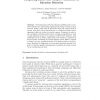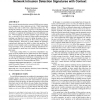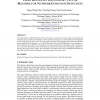201 search results - page 16 / 41 » Active learning for network intrusion detection |
ISNN
2005
Springer
14 years 3 months ago
2005
Springer
Current Intrusion Detection Systems (IDS) examine all data features to detect intrusion or misuse patterns. Some of the features may be redundant or contribute little (if anything)...
JAIR
2010
13 years 5 months ago
2010
Intrusion detection systems (IDSs) fall into two high-level categories: network-based systems (NIDS) that monitor network behaviors, and host-based systems (HIDS) that monitor sys...
CORR
2010
Springer
13 years 10 months ago
2010
Springer
Abstract. Network Intrusion Detection Systems (NIDS) monitor a network with the aim of discerning malicious from benign activity on that network. While a wide range of approaches h...
CCS
2003
ACM
14 years 3 months ago
2003
ACM
Many network intrusion detection systems (NIDS) use byte sequences as signatures to detect malicious activity. While being highly efficient, they tend to suffer from a high false...
CORR
2010
Springer
13 years 10 months ago
2010
Springer
The main function of IDS (Intrusion Detection System) is to protect the system, analyze and predict the behaviors of users. Then these behaviors will be considered an attack or a ...



